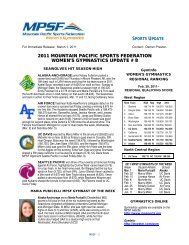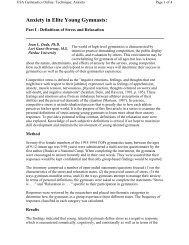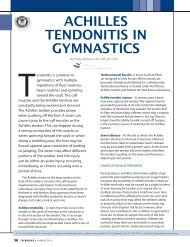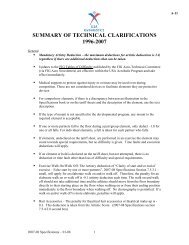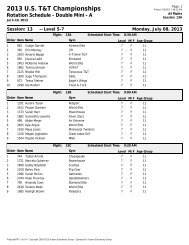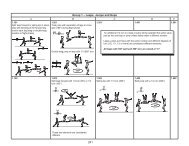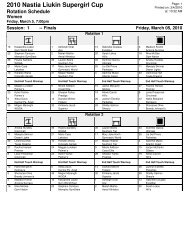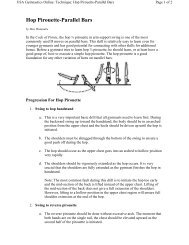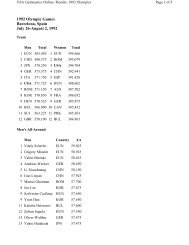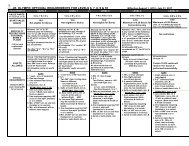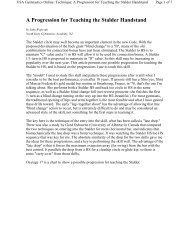Strength Training Fundamentals in Gymnastics ... - USA Gymnastics
Strength Training Fundamentals in Gymnastics ... - USA Gymnastics
Strength Training Fundamentals in Gymnastics ... - USA Gymnastics
You also want an ePaper? Increase the reach of your titles
YUMPU automatically turns print PDFs into web optimized ePapers that Google loves.
<strong>USA</strong> <strong>Gymnastics</strong> Onl<strong>in</strong>e: Technique: <strong>Strength</strong> <strong>Tra<strong>in</strong><strong>in</strong>g</strong> <strong>Fundamentals</strong> <strong>in</strong> <strong>Gymnastics</strong> Con...<br />
Page 1 of 14<br />
Condition<strong>in</strong>g<br />
<strong>Strength</strong> <strong>Tra<strong>in</strong><strong>in</strong>g</strong> <strong>Fundamentals</strong> <strong>in</strong> <strong>Gymnastics</strong><br />
Condition<strong>in</strong>g<br />
James J. Major<br />
Motor Behavior Laboratory<br />
Dept. of Exercise and Sports Science<br />
University of Utah<br />
Salt Lake City, Utah<br />
Often coaches must be a jack-of-all-trades, but masters of one. <strong>Gymnastics</strong> coaches are<br />
responsible for not only skill tra<strong>in</strong><strong>in</strong>g, rout<strong>in</strong>e composition, safety, education, and mental<br />
health of their gymnasts, but also their condition<strong>in</strong>g. To help the coach with condition<strong>in</strong>g,<br />
there is a plethora of advice and equipment. However gymnastics coaches need fundamental<br />
<strong>in</strong>formation to evaluate these products and suggestions; and yes, even see through the<br />
grantsmanship of the sport scientists. Understand<strong>in</strong>g basic pr<strong>in</strong>ciples, coaches can sift<br />
through the advice and choose the best condition<strong>in</strong>g for their gymnasts.<br />
To help coaches towards understand<strong>in</strong>g basic pr<strong>in</strong>ciples of strength tra<strong>in</strong><strong>in</strong>g, the U.S. Elite<br />
Coaches Association for Women's <strong>Gymnastics</strong> (USECA–W) has had translated an excellent<br />
article on strength tra<strong>in</strong><strong>in</strong>g fundamentals (Bührle and Werner, 1984). The translation of<br />
"The Muscle Hypertrophy <strong>Tra<strong>in</strong><strong>in</strong>g</strong> of the Body Builder" (Bührle and Werner, 1984) is<br />
available from the USECA.<br />
I want to expla<strong>in</strong> how these fundamentals should be applied <strong>in</strong> gymnastics. Four basic<br />
pr<strong>in</strong>ciples that will help coaches to evaluate strength tra<strong>in</strong><strong>in</strong>g are:<br />
� Consistent, special strength tra<strong>in</strong><strong>in</strong>g is necessary for maximum performance <strong>in</strong><br />
gymnastics;<br />
� <strong>Tra<strong>in</strong><strong>in</strong>g</strong> to <strong>in</strong>crease muscle size and strength is important, but maximum strength<br />
from m<strong>in</strong>imum size is the most important tra<strong>in</strong><strong>in</strong>g goal;<br />
� Rest and recuperation are important aspects of strength tra<strong>in</strong><strong>in</strong>g, also <strong>in</strong> gymnastics;<br />
� <strong>Strength</strong> tra<strong>in</strong><strong>in</strong>g must be <strong>in</strong>tegrated with the skill tra<strong>in</strong><strong>in</strong>g <strong>in</strong> gymnastics.<br />
Consistent, special strength tra<strong>in</strong><strong>in</strong>g is necessary for the best possible<br />
performance <strong>in</strong> gymnastics.<br />
One of the most important <strong>in</strong>sights of modern tra<strong>in</strong><strong>in</strong>g is that a highly developed level of<br />
strength cannot be ma<strong>in</strong>ta<strong>in</strong>ed even by <strong>in</strong>tensive performance of the event itself (Bührle and<br />
Werner, 1984). This <strong>in</strong>sight has proven to be true <strong>in</strong> such very different events as<br />
swimm<strong>in</strong>g, cross-country ski<strong>in</strong>g, and gymnastics. <strong>Gymnastics</strong> alone will not develop nor<br />
even ma<strong>in</strong>ta<strong>in</strong> an adequate level of strength for advanced gymnastics (Oppel, 1967). Special<br />
condition<strong>in</strong>g must be performed, besides countless elements, comb<strong>in</strong>ations, parts, and full<br />
rout<strong>in</strong>es. Inconsistent strength tra<strong>in</strong><strong>in</strong>g can expla<strong>in</strong> the decl<strong>in</strong>e <strong>in</strong> performance, or at least<br />
the stagnation, of a number of athletes who had promis<strong>in</strong>g performances dur<strong>in</strong>g the<br />
preparatory season. Once those athletes started to compete, their results did not live up to<br />
these expectations (Bührle and Werner, 1984). <strong>Gymnastics</strong> specialists have warned aga<strong>in</strong>st<br />
decreas<strong>in</strong>g strength tra<strong>in</strong><strong>in</strong>g dur<strong>in</strong>g the competition season (Borrmann, 1978: Hartig and<br />
Buchmann, 1988; Plotk<strong>in</strong>, Rub<strong>in</strong> and Arkaev, 1983; Ukran, 1969).
<strong>USA</strong> <strong>Gymnastics</strong> Onl<strong>in</strong>e: Technique: <strong>Strength</strong> <strong>Tra<strong>in</strong><strong>in</strong>g</strong> <strong>Fundamentals</strong> <strong>in</strong> <strong>Gymnastics</strong> Con...<br />
Page 2 of 14<br />
Special strength for gymnastics tra<strong>in</strong><strong>in</strong>g must answer the demands of gymnastics. The<br />
pr<strong>in</strong>ciple of specificity implies that the exercises used <strong>in</strong> tra<strong>in</strong><strong>in</strong>g should be similar to the<br />
exercises that must be performed <strong>in</strong> the competition rout<strong>in</strong>e. Therefore, we might imag<strong>in</strong>e<br />
that the best tra<strong>in</strong><strong>in</strong>g for gymnastics would be more gymnastics. However, long ago this<br />
was proven not to be the case (Borrmann, 1978; Oppel, 1967; Plotk<strong>in</strong>, Rub<strong>in</strong>, and Arkaev,<br />
1983). Special tra<strong>in</strong><strong>in</strong>g is necessary to develop the strength and power <strong>in</strong> the athlete<br />
sufficient for correct technical performance of skills (Hartig and Buchmann, 1988; Oppel,<br />
1967). Repetition of the skill alone will not guarantee even a m<strong>in</strong>imum level of strength to<br />
perform the skill correctly.<br />
The observation that a highly developed level of strength cannot be ma<strong>in</strong>ta<strong>in</strong>ed even by the<br />
most <strong>in</strong>tensive performance of the movements of the competition rout<strong>in</strong>es does not<br />
contradict the pr<strong>in</strong>ciple of specificity, but completes it (Bührle and Werner, 1984; Mart<strong>in</strong>,<br />
1991; Verchoshanskij, 1985). Special strength tra<strong>in</strong><strong>in</strong>g is necessary, but it must specifically<br />
meet the demands of the event, <strong>in</strong> this case gymnastics skills. What is specific for<br />
gymnastics will be discussed below.<br />
<strong>Tra<strong>in</strong><strong>in</strong>g</strong> to <strong>in</strong>crease muscle size and strength is important, but maximum<br />
strength from m<strong>in</strong>imum size is the most important tra<strong>in</strong><strong>in</strong>g goal.<br />
Muscle size and strength are related. The thicker a muscle fiber, the stronger it can contract,<br />
and the more tension or force the muscle can generate. The sum of all the cross-sectional<br />
surface areas of all of the fibers determ<strong>in</strong>es the size of the muscle cross-section, and thereby<br />
the potential for strength. This fact is particularly true for the lean, well-tra<strong>in</strong>ed muscle of an<br />
athlete. The cross-sectional surface area of the muscle thereby becomes the most important<br />
trait for estimat<strong>in</strong>g strength (Bührle and Werner, 1984).<br />
Increas<strong>in</strong>g the cross sectional area of the muscle, or muscle hypertrophy, is fundamental for<br />
maximal improvement of strength (Bührle and Werner, 1984). However, we must admit<br />
that the exact biochemical mechanism for muscle hypertrophy, what factors cause it, and<br />
therefore how to best go about achiev<strong>in</strong>g or avoid<strong>in</strong>g muscle hypertrophy is still unknown<br />
(MacDougall, 1986; Hartmann and Tünnemann, 1988). Muscle hypertrophy is most<br />
important <strong>in</strong> body build<strong>in</strong>g, but a survey of elite Swedish bodybuilders found no agreement<br />
on how to best achieve muscle hypertrophy (Tesch, 1986).<br />
The cross-sectional area of the muscle <strong>in</strong>creases with strength tra<strong>in</strong><strong>in</strong>g because am<strong>in</strong>o acids<br />
(prote<strong>in</strong>s) are added to the muscle after tra<strong>in</strong><strong>in</strong>g. There are at least two theories of exactly<br />
why and how prote<strong>in</strong>s are added to the muscle because of work or tra<strong>in</strong><strong>in</strong>g. One is the ATPdeficit<br />
theory of muscle hypertrophy, Adenos<strong>in</strong>triphosphate (ATP), is the immediate source<br />
of energy for contraction <strong>in</strong> the muscle. The ATP-deficit theory states that muscle growth is<br />
stimulated by a disturbance of the balance between production and consumption of ATP.<br />
ATP is essential for life but is only stored <strong>in</strong> limited quantities <strong>in</strong> the muscle (Figure 1).<br />
ATP-deficit <strong>in</strong> the muscle, particularly if it is the result of <strong>in</strong>tensive maximal strength and<br />
power efforts, seems to provoke extra riboneucleic acid (RNA) synthesis. In turn, RNA<br />
stimulates muscle growth. Although it has been demonstrated that <strong>in</strong>creased synthesis of<br />
messenger RNA is an essential requirement for the hypertrophy process (Lundholm, 1986),<br />
the stimulus for <strong>in</strong>creased muscle uptake of prote<strong>in</strong> apparently occurs before there is any<br />
evidence of <strong>in</strong>creased RNA synthesis (MacDougall, 1986). An ATP-deficit probably also<br />
<strong>in</strong>fluences prote<strong>in</strong> metabolism because the body requires ATP to compound am<strong>in</strong>o acids<br />
<strong>in</strong>to prote<strong>in</strong> and more muscle.
<strong>USA</strong> <strong>Gymnastics</strong> Onl<strong>in</strong>e: Technique: <strong>Strength</strong> <strong>Tra<strong>in</strong><strong>in</strong>g</strong> <strong>Fundamentals</strong> <strong>in</strong> <strong>Gymnastics</strong> Con...<br />
Page 3 of 14<br />
Figure 1. Fraction of the different metabolic substances <strong>in</strong> the supply of<br />
energy at cont<strong>in</strong>uous, maximum effort.<br />
ATP and CP are the sources of energy for gymnastics. ATP and CP stores can be rapidly<br />
replenished. It is well known that there is little lactic acid <strong>in</strong> the blood of elite gymnasts after<br />
the floor exercise and optional pommel horse, so these rout<strong>in</strong>es apparently do not substantially<br />
tax anaerobic glycolysis and aerobic metabolism. Perhaps there are enough relatively easy<br />
phases dur<strong>in</strong>g which ATP and CP can be restored. (Modified after Kuel et al <strong>in</strong> Bührle and<br />
Werner, 1984)<br />
Intensive maximal strength and power exercises cause not only ATP-deficit but also<br />
damage to the body prote<strong>in</strong>s. This damage occurs to components of the muscle fibers<br />
(structural prote<strong>in</strong>s) as well as enzymes and hormones (functional prote<strong>in</strong>s). Both structural<br />
and functional prote<strong>in</strong>s are important for muscular contraction. Large concentrations of<br />
nitrogens excreted by the body after such efforts is evidence of the use of these prote<strong>in</strong>s.<br />
These prote<strong>in</strong>s are then rebuilt and supercompensated (Figure 2).<br />
Figure 2. Schematic process of tra<strong>in</strong><strong>in</strong>g load and adaptation (Matveyev,<br />
1971)
<strong>USA</strong> <strong>Gymnastics</strong> Onl<strong>in</strong>e: Technique: <strong>Strength</strong> <strong>Tra<strong>in</strong><strong>in</strong>g</strong> <strong>Fundamentals</strong> <strong>in</strong> <strong>Gymnastics</strong> Con...<br />
Page 4 of 14<br />
Increas<strong>in</strong>g cross-sectional area of the muscle with strength tra<strong>in</strong><strong>in</strong>g is the result of the<br />
addition of contractile prote<strong>in</strong>s to the muscle after tra<strong>in</strong><strong>in</strong>g. However, when a muscle<br />
hypertrophies from tra<strong>in</strong><strong>in</strong>g, other components also <strong>in</strong>crease. Body builders have <strong>in</strong>creased<br />
amounts of connective tissue <strong>in</strong> the muscle (MacDougall, 1986). Hypertrophied muscles<br />
also have <strong>in</strong>creased rest<strong>in</strong>g concentrations of ATP and creat<strong>in</strong> phosphate (CP) (Hartmann<br />
and Tünnemann, 1988). More connective tissue and <strong>in</strong>creased stores of ATP and CP also<br />
<strong>in</strong>crease the volume, or cross-sectional area of the muscle. Moreover, I suspect that ATP<br />
and CP are the key sources of energy for gymnastics performance. I also suspect that ATP<br />
and CP are so important because well tra<strong>in</strong>ed gymnasts have little lactic acid <strong>in</strong> their blood<br />
after complet<strong>in</strong>g full rout<strong>in</strong>es. The two ma<strong>in</strong> endurance problems <strong>in</strong> gymnastics, the last<br />
tumbl<strong>in</strong>g pass dur<strong>in</strong>g the floor exercise and men's optional pommel horse rout<strong>in</strong>es, are<br />
probably related to ATP and CP stores, and thereby of the size of the ma<strong>in</strong> muscles used <strong>in</strong><br />
those events. ATP and CP stores <strong>in</strong> the muscles are probably depleted <strong>in</strong> f<strong>in</strong>ish<strong>in</strong>g<br />
gymnastics rout<strong>in</strong>es (see Figure 1). Therefore, muscle size is basic for endurance <strong>in</strong><br />
gymnastics.<br />
There are other theories that attempt to expla<strong>in</strong> muscle hypertrophy besides the ATP-deficit<br />
theory. However, the bottom l<strong>in</strong>e <strong>in</strong> strength tra<strong>in</strong><strong>in</strong>g is that the muscle must be bigger <strong>in</strong><br />
order to be stronger. It is trite, but bigger muscles identify athletes better than any other<br />
physical attribute. This is also true for the male and female gymnast. However, gymnastics<br />
coaches also know that among the very best gymnasts many gymnasts with the biggest<br />
muscles are the weakest <strong>in</strong> the strength elements. Many gymnasts with the most exceptional<br />
strength moves do not have big muscles for a gymnast. How is this contradiction between<br />
physiology and gymnastics expla<strong>in</strong>ed?<br />
Most important for gymnastics is the <strong>in</strong>sight that maximal strength can also be <strong>in</strong>creased<br />
without <strong>in</strong>creas<strong>in</strong>g muscle mass (Bührle and Werner, 1984; Poliqu<strong>in</strong>, 1991; Verchoshanskij,<br />
1985). Increas<strong>in</strong>g strength without <strong>in</strong>creas<strong>in</strong>g muscle mass is important <strong>in</strong> gymnastics<br />
because the gymnast must move his or her own body. In gymnastics the power-to-bodyweight<br />
ratio is a factor that decisively <strong>in</strong>fluences performance. It is the power-to-weight<br />
ratio that strongly <strong>in</strong>fluences gymnastics performance, not strength alone.<br />
We do not use all of the fibers <strong>in</strong> a muscle at once, but some use more fibers than others. An<br />
athlete's maximal strength is ma<strong>in</strong>ly determ<strong>in</strong>ed by the number of muscle fibers recruited by<br />
the nervous system for the movement, together with the cross-sectional surface area of these<br />
fibers. Only 70 to 90 percent of the potential strength, determ<strong>in</strong>ed by the cross-sectional<br />
surface area of the muscle, can be voluntarily activated and applied to athletic movements.<br />
Only by stimulat<strong>in</strong>g the muscle with electricity at a high frequency (100 Hz and higher) will<br />
permit all muscle fibers, and thereby the entire potential of the muscle, to be activated at<br />
once (Strojnik, 1995).<br />
With the appropriate assistance, for example, stimulation of the muscle with electricity, the<br />
entire potential of the muscle to produce force can be measured. The potential strength<br />
value measured <strong>in</strong> this way is termed the absolute strength. The highest strength value<br />
produced by voluntary contraction is the maximal strength of the athlete. An athlete's<br />
maximal strength will usually be lower than that athlete's absolute strength. The difference<br />
between the absolute strength and the maximal strength is termed the strength deficit<br />
(Bührle and Schmidtbleicher, 1981). This is because even well tra<strong>in</strong>ed athletes cannot use<br />
all of the fibers <strong>in</strong> their muscles at once. A "big" muscle is not necessarily the strongest one,<br />
particularly if a substantial fraction of the absolute strength cannot be voluntarily and<br />
skillfully applied. This is the strength deficit. Muscle hypertrophy tra<strong>in</strong><strong>in</strong>g like the REF
<strong>USA</strong> <strong>Gymnastics</strong> Onl<strong>in</strong>e: Technique: <strong>Strength</strong> <strong>Tra<strong>in</strong><strong>in</strong>g</strong> <strong>Fundamentals</strong> <strong>in</strong> <strong>Gymnastics</strong> Con...<br />
Page 5 of 14<br />
program will tend to <strong>in</strong>crease the strength deficit, while maximal strength tra<strong>in</strong><strong>in</strong>g like the<br />
MAX program will tend to decrease the gymnast's strength deficit (Table 1). For example,<br />
body builders usually have a very high absolute strength, but also a relatively large strength<br />
deficit.<br />
Table 1. Comparison of the tra<strong>in</strong><strong>in</strong>g rout<strong>in</strong>es of the three experimental groups <strong>in</strong> the<br />
experiment (Bührle and Werner, 1984)<br />
MAX GROUP: Repeated maximal strength efforts<br />
3 sets of 3 repetitions @ 90% of 1RM<br />
2 sets of 2 repetitions @ 95% of 1RM<br />
2 sets of 2 repetitions @ 97% of 1RM<br />
1 set of 1 repetition @ 100% of 1RM<br />
Total: 18 repetitions <strong>in</strong> 8 sets with an average <strong>in</strong>tensity of 94.3% of 1RM.<br />
Pauses between sets: 3 m<strong>in</strong>utes<br />
Performance of the movements: explosive contraction<br />
This k<strong>in</strong>d of program is appropriate for reduc<strong>in</strong>g the strength deficit.<br />
REF GROUP: Repeated strength efforts until failure<br />
3 sets of 12 repetitions @ 70% of 1RM<br />
Total: 36 repetitions <strong>in</strong> 3 sets with an average <strong>in</strong>tensity of 70% of 1 RM.<br />
Pauses between sets: 2 m<strong>in</strong>utes<br />
Performance of the movements: repetitions to failure.<br />
This k<strong>in</strong>d of program is appropriate for muscle hypertrophy, <strong>in</strong>creas<strong>in</strong>g<br />
absolute strength, or body build<strong>in</strong>g.<br />
POWER GROUP: Power tra<strong>in</strong><strong>in</strong>g method<br />
5 sets of 7 repetitions @ 45% of 1RM<br />
Total 35 repetitions <strong>in</strong> 5 sets with an average <strong>in</strong>tensity of 45% of 1 RM.<br />
Pauses between sets: 5 m<strong>in</strong>utes<br />
Performance of the movements: as rapidly as possible. This k<strong>in</strong>d of<br />
program produces almost as much muscle hypertrophy as repeated efforts<br />
to failure (REF).<br />
Note: The relative level of the tra<strong>in</strong><strong>in</strong>g load was readjusted every week to the<br />
improv<strong>in</strong>g level of maximal strength (1RM). 1RM is the one repetition<br />
maximum or the heaviest weight the athlete can lift one time.<br />
<strong>Strength</strong> may be <strong>in</strong>creased without <strong>in</strong>creas<strong>in</strong>g the size of the muscle by reduc<strong>in</strong>g the<br />
strength deficit. The tra<strong>in</strong><strong>in</strong>g methods used are similar to that of Bührle and Werner's MAX<br />
group (repeated maximal strength efforts). Notice that this group had a substantial <strong>in</strong>crease<br />
<strong>in</strong> maximal strength, but with the least <strong>in</strong>crease <strong>in</strong> muscle mass (Table 2). With the MAX
<strong>USA</strong> <strong>Gymnastics</strong> Onl<strong>in</strong>e: Technique: <strong>Strength</strong> <strong>Tra<strong>in</strong><strong>in</strong>g</strong> <strong>Fundamentals</strong> <strong>in</strong> <strong>Gymnastics</strong> Con...<br />
Page 6 of 14<br />
program the muscle simply does not do enough repetitions to go <strong>in</strong>to ATP deficit and<br />
hypertrophy (Bührle and Werner, 1984; Hartmann and Tünnemann, 1988). Instead, here<br />
strength is <strong>in</strong>creased by <strong>in</strong>creas<strong>in</strong>g maximal strength without little <strong>in</strong>crease <strong>in</strong> muscle size,<br />
thereby reduc<strong>in</strong>g the strength deficit.<br />
Table 2. The results of tra<strong>in</strong><strong>in</strong>g with different methods (12 weeks) (Bührle and<br />
Werner, 1984).<br />
N refers to Newtons, a measure of force.<br />
1 pound of force is equal to approximately 4.5 Newtons.<br />
Mm² is a measure of surface area of the muscle measured with computed tomography.<br />
MAX: This group used a tra<strong>in</strong><strong>in</strong>g program for improv<strong>in</strong>g maximal strength, with a<br />
m<strong>in</strong>imum muscle hypertrophy effect, thereby reduc<strong>in</strong>g the strength deficit. This group used<br />
the lowest number of repetitions, but the highest average <strong>in</strong>tensity, and <strong>in</strong>termediate rest<br />
periods.<br />
REF: This group used a tra<strong>in</strong><strong>in</strong>g program for <strong>in</strong>creas<strong>in</strong>g strength by <strong>in</strong>creas<strong>in</strong>g the crosssectional<br />
area of the muscle (muscle hypertrophy). This group used the highest number of<br />
repetitions at an <strong>in</strong>termediate <strong>in</strong>tensity, and the shortest rest periods. The result was<br />
<strong>in</strong>tensive fatigue.<br />
POWER: This group used a tra<strong>in</strong><strong>in</strong>g program for improv<strong>in</strong>g power and quickness. This<br />
group used almost the highest number of repetitions, the next highest number of sets, but<br />
the highest speed of movement, and the longest rest periods.<br />
Special, specific strength tra<strong>in</strong><strong>in</strong>g for an event provokes an adaptation of the neural<br />
<strong>in</strong>nervation processes that control the skill. The fraction of the absolute strength that can be<br />
voluntary activated may be <strong>in</strong>creased with maximal strength tra<strong>in</strong><strong>in</strong>g. Consequently,<br />
maximal strength can be <strong>in</strong>creased by other means than by <strong>in</strong>creas<strong>in</strong>g the cross-sectional<br />
surface area of the muscle. An example of a tra<strong>in</strong><strong>in</strong>g program that will <strong>in</strong>crease the maximal<br />
strength of the athlete, without <strong>in</strong>creas<strong>in</strong>g the muscle size (absolute strength), would be the<br />
program of the MAX group <strong>in</strong> Bührle and Werner's experiment (see Table 1). However,<br />
coaches and athletes should recognize the fact that improvement by this method is limited<br />
by the morphologically available muscular mass, <strong>in</strong> other words by the absolute strength<br />
level. Therefore, a gymnast's condition<strong>in</strong>g should alternate between muscle hypertrophy and<br />
maximal strength tra<strong>in</strong><strong>in</strong>g, between the tra<strong>in</strong><strong>in</strong>g processes shown <strong>in</strong> Figures 3 and 4<br />
(Schmidtbleicher, 1992). Dur<strong>in</strong>g tra<strong>in</strong><strong>in</strong>g periods when relatively many whole and part<br />
rout<strong>in</strong>es are completed, the special strength tra<strong>in</strong><strong>in</strong>g should be like that <strong>in</strong> Figure 4, us<strong>in</strong>g a<br />
program like that of the MAX group <strong>in</strong> Table 1. The reason for emphasiz<strong>in</strong>g tra<strong>in</strong><strong>in</strong>g like
<strong>USA</strong> <strong>Gymnastics</strong> Onl<strong>in</strong>e: Technique: <strong>Strength</strong> <strong>Tra<strong>in</strong><strong>in</strong>g</strong> <strong>Fundamentals</strong> <strong>in</strong> <strong>Gymnastics</strong> Con...<br />
Page 7 of 14<br />
Figure 4 is to keep muscle hypertrophy and the strength deficit as low as possible dur<strong>in</strong>g<br />
this rout<strong>in</strong>e tra<strong>in</strong><strong>in</strong>g period.<br />
Figure 3. The course of a typical muscle hypertrophy tra<strong>in</strong><strong>in</strong>g.<br />
Notice that the diameter of the muscle <strong>in</strong>creases as the diameter of the fibers <strong>in</strong>creases. With<br />
this tra<strong>in</strong><strong>in</strong>g, the number of the fibers <strong>in</strong> the muscle that are activated does not <strong>in</strong>crease. This<br />
effect is produced by a tra<strong>in</strong><strong>in</strong>g like REF <strong>in</strong> Table 1. (Modified after Hartmann and<br />
Tünnemann, 1988)<br />
Figure 4. The course of a typical maximal strength tra<strong>in</strong><strong>in</strong>g.<br />
Notice that the diameter of the muscle depicted as circles does not <strong>in</strong>crease while the ability to<br />
activate more muscle fibers <strong>in</strong>creases. This effect is produced by a tra<strong>in</strong><strong>in</strong>g like the MAX group<br />
<strong>in</strong> Table 1. (Modified after Hartmann and Tünnemann, 1988)
<strong>USA</strong> <strong>Gymnastics</strong> Onl<strong>in</strong>e: Technique: <strong>Strength</strong> <strong>Tra<strong>in</strong><strong>in</strong>g</strong> <strong>Fundamentals</strong> <strong>in</strong> <strong>Gymnastics</strong> Con...<br />
Page 8 of 14<br />
Rest and recuperation are important aspects of strength tra<strong>in</strong><strong>in</strong>g, also <strong>in</strong><br />
gymnastics.<br />
It is a common idea <strong>in</strong> tra<strong>in</strong><strong>in</strong>g that fatigue develops strength. This idea is particularly<br />
popular among athletes who tra<strong>in</strong> for muscle size, for example bodybuilders, football<br />
players, and throwers <strong>in</strong> the field events (Brunner and Tabachnik, 1990; Bührle and Werner,<br />
1984). A rapid exhaustion of ATP stores has been associated with the "burn<strong>in</strong>g" feel<strong>in</strong>g <strong>in</strong><br />
the muscle. This pa<strong>in</strong>ful feel<strong>in</strong>g often accompanies strength tra<strong>in</strong><strong>in</strong>g sets with heavy loads<br />
(70%) and many repetitions (8-15). This k<strong>in</strong>d of strength tra<strong>in</strong><strong>in</strong>g tends to be very fatigu<strong>in</strong>g<br />
and is also the k<strong>in</strong>d of tra<strong>in</strong><strong>in</strong>g that make the muscles <strong>in</strong>crease <strong>in</strong> size, or hypertrophy. If the<br />
load is less, but the speed of movement is very fast, the effect may be the same: muscle<br />
growth (Table 2; Bührle and Werner, 1984).<br />
Figure 2 shows the time course of the tra<strong>in</strong><strong>in</strong>g process. Notice that this graph also shows<br />
that rest is also necessary if strength is to <strong>in</strong>crease. Chronic fatigue tends to reduce effects of<br />
the strength tra<strong>in</strong><strong>in</strong>g on muscle size. In fact, it has been shown that strength and power<br />
tra<strong>in</strong><strong>in</strong>g while chronically fatigued decreases the effects of strength tra<strong>in</strong><strong>in</strong>g<br />
(Verchoshanskij, 1985). Bodybuilders often use split rout<strong>in</strong>es strength tra<strong>in</strong><strong>in</strong>g every day,<br />
but a muscle group only every other day (Bührle and Werner, 1984; Tesch, 1986).<br />
Heavy fatigue from strength tra<strong>in</strong><strong>in</strong>g has other effects that are important <strong>in</strong> gymnastics.<br />
Heavy fatigue from strength tra<strong>in</strong><strong>in</strong>g can be very detrimental to coord<strong>in</strong>ation and technique.<br />
When gymnasts perform powerful movements, their nervous system is heavily <strong>in</strong>volved and<br />
their coord<strong>in</strong>ation is also improved by this tra<strong>in</strong><strong>in</strong>g (Borrmann. 1978). Therefore, maximal<br />
strength tra<strong>in</strong><strong>in</strong>g should be performed when the gymnast is warm, but relatively fresh.<br />
<strong>Tra<strong>in</strong><strong>in</strong>g</strong> periods where strength tra<strong>in</strong><strong>in</strong>g is emphasized should be separated from periods<br />
where skill learn<strong>in</strong>g is emphasized (Major, 1993; Verchoshanskij, 1985).<br />
<strong>Strength</strong> tra<strong>in</strong><strong>in</strong>g must be <strong>in</strong>tegrated with the skill tra<strong>in</strong><strong>in</strong>g <strong>in</strong> gymnastics.<br />
Modern strength tra<strong>in</strong><strong>in</strong>g and condition<strong>in</strong>g has two priorities:<br />
� On one hand, tra<strong>in</strong><strong>in</strong>g should improve the cross-sectional surface area of all muscle<br />
fibers, and thereby the absolute strength.<br />
� On the other hand, this potential, absolute strength must be able to be applied with<br />
maximal effect, <strong>in</strong> a manner specific to the event. Apply<strong>in</strong>g strength, with maximal<br />
effect, specific for the event, is achieved with skill practice and tra<strong>in</strong><strong>in</strong>g (Bührle and<br />
Werner, 1984).<br />
Correct technical execution is often impossible without sufficient strength. Performance of<br />
gymnastics skills with virtuosity often demands a great deal of strength. With <strong>in</strong>sufficient<br />
strength, the gymnast learns a skill with one technique only to have to relearn the skill when<br />
he or she has <strong>in</strong>creased strength. Relearn<strong>in</strong>g can be very time-consum<strong>in</strong>g, frustrat<strong>in</strong>g, and is<br />
a substantial source of <strong>in</strong>efficiency <strong>in</strong> the tra<strong>in</strong><strong>in</strong>g process (FKS, 1988). Alternative methods<br />
are:<br />
1. Develop sufficient strength before learn<strong>in</strong>g the skill (sequential strength-skill<br />
development), and<br />
2. Spot or assist the gymnast with <strong>in</strong>sufficient strength for technically good performance<br />
dur<strong>in</strong>g performance of the skill while strength is be<strong>in</strong>g developed (simultaneous skill-
<strong>USA</strong> <strong>Gymnastics</strong> Onl<strong>in</strong>e: Technique: <strong>Strength</strong> <strong>Tra<strong>in</strong><strong>in</strong>g</strong> <strong>Fundamentals</strong> <strong>in</strong> <strong>Gymnastics</strong> Con...<br />
Page 9 of 14<br />
strength improvement). As well, any loss of strength will deteriorate the technical<br />
performance of a skill that the gymnast has already mastered.<br />
Specific for gymnastics skills are the muscle groups that need hypertrophy, and which<br />
muscle groups do not. After observation of the morphology of the world's elite gymnasts <strong>in</strong><br />
several European, National, and World Championships events, I believe that elite gymnasts<br />
of both genders appear to need hypertrophied:<br />
� elbow extensors (movement: straighten<strong>in</strong>g the elbow jo<strong>in</strong>t; typical exercise: bar dips<br />
or hand stand pushups)<br />
� plantar flexors (movement: stand<strong>in</strong>g up on toe; typical exercise: stand<strong>in</strong>g toe raises)<br />
� shoulder (hyper-) flexors (movement: lift<strong>in</strong>g the arms above and past the head; typical<br />
exercise: press to handstand)<br />
� sternoclavicular jo<strong>in</strong>t elevators and depressors (movement: lift<strong>in</strong>g or push<strong>in</strong>g down<br />
the shoulders and arms; typical exercise: straight arm lat pulldowns or <strong>in</strong>cl<strong>in</strong>e bench<br />
press)<br />
� hip extensors (movement: kick<strong>in</strong>g the thigh back; typical exercise: cast to handstand)<br />
� shoulder extensors (movement: push<strong>in</strong>g the arms down and beh<strong>in</strong>d the back; typical<br />
exercise: Manna)<br />
� In addition, the male gymnast must have hypertrophied:<br />
� shoulder adductors and horizontal adductors (movement: end of front giant <strong>in</strong> r<strong>in</strong>gs,<br />
cross; typical exercise: flys)<br />
� elbow flexors (movement: bend<strong>in</strong>g the elbows; typical exercise: <strong>in</strong>itial pull up to<br />
Asarjian <strong>in</strong> r<strong>in</strong>gs)<br />
The above list does not ignore the fact that many of the <strong>in</strong>dividual muscles that participate<br />
<strong>in</strong> these movements also participate <strong>in</strong> other movements important for technically perfect<br />
gymnastics, for example by stabiliz<strong>in</strong>g the jo<strong>in</strong>t (stabilizers). For technically correct<br />
gymnastics, almost all other muscle groups than the above list must be very strong. The<br />
muscle groups must have m<strong>in</strong>imum muscle mass and m<strong>in</strong>imum strength deficit. This is<br />
particularly the case for all (remote) jo<strong>in</strong>t stabilizer muscles of the body.<br />
<strong>Strength</strong> <strong>Tra<strong>in</strong><strong>in</strong>g</strong> Pr<strong>in</strong>ciples for <strong>Gymnastics</strong><br />
Muscle size is important for strength, but gymnastics condition<strong>in</strong>g must not become body<br />
build<strong>in</strong>g. Absolute strength does <strong>in</strong>crease with body mass. Among tra<strong>in</strong>ed athletes, the<br />
bigger the person, the more weight they can usually lift. This relationship between body<br />
size and strength can be seen <strong>in</strong> the graph compar<strong>in</strong>g weight lifted <strong>in</strong> the Olympic<br />
weightlift<strong>in</strong>g events (world records) compared to weight class (Figure 5). However, the<br />
strength of an athlete relative to their body size decreases as the body mass of the weight<br />
lifter <strong>in</strong>creases (Figure 6). The world record <strong>in</strong> relative strength is held by an athlete <strong>in</strong> the<br />
60 kg (125 lb.) class who snatched three times his own body weight with one movement<br />
over his head! Olympic weightlift<strong>in</strong>g is an extreme power, technique, and quickness event<br />
like gymnastics. We must remember that the power-to-body-weight ratio IS an important<br />
performance determ<strong>in</strong><strong>in</strong>g factor <strong>in</strong> gymnastics. A gymnast must lift his or her body mass<br />
with their legs when tumbl<strong>in</strong>g or with their arms on bars. As the mass of the gymnast<br />
<strong>in</strong>creases, they <strong>in</strong>evitably tend to slide down the curve <strong>in</strong> Figure 6, and their gymnastics<br />
performance will tend to suffer.
<strong>USA</strong> <strong>Gymnastics</strong> Onl<strong>in</strong>e: Technique: <strong>Strength</strong> <strong>Tra<strong>in</strong><strong>in</strong>g</strong> <strong>Fundamentals</strong> <strong>in</strong> <strong>Gymnastics</strong> C...<br />
Figure 5. The relationship between maximal strength and body mass<br />
exemplified by the World Records <strong>in</strong> Olympic Weightlift<strong>in</strong>g.<br />
The heavier the athlete, the more weight is lifted. (Modified after Hartmann and Tünnemann,<br />
1988; Tittle and Wutscherk, 1992)<br />
Figure 6. The relationship between maximal strength and body mass<br />
exemplified by the World Records <strong>in</strong> Olympic Weightlift<strong>in</strong>g.<br />
The heavier the athlete, the less weight is lifted per kilogram body mass. (Modified after<br />
Hartmann and Tünnemann, 1988; Tittle and Wutscherk, 1992)<br />
Page 10 of 14<br />
The power-to-body-weight ratio is perhaps the real reason why the taller and heavier<br />
gymnasts seem to have more difficulty succeed<strong>in</strong>g <strong>in</strong> gymnastics. The taller the athlete is,<br />
the greater his or her body mass will be, and the worse the relative strength. If this is <strong>in</strong>deed<br />
the case, then the tra<strong>in</strong><strong>in</strong>g of the taller gymnast must concentrate on the highest relative<br />
strength and lowest strength deficit.
<strong>USA</strong> <strong>Gymnastics</strong> Onl<strong>in</strong>e: Technique: <strong>Strength</strong> <strong>Tra<strong>in</strong><strong>in</strong>g</strong> <strong>Fundamentals</strong> <strong>in</strong> <strong>Gymnastics</strong> C...<br />
I believe the problem of the taller gymnast is analogous to the loss of performance and<br />
strength commonly seen <strong>in</strong> the pubertal gymnast. Well tra<strong>in</strong>ed 10-year-old girls and 12year-old<br />
boys commonly show comparatively high values of relative strength. But as<br />
children and teenagers become taller and therefore heavier, their relative strength should<br />
decrease. Relative strength often does seem to decrease, especially dur<strong>in</strong>g pubertal growth<br />
spurts and skill performance deteriorates at the same time. In the case of the pubertal male<br />
gymnast, the problem is due to a relative strength that cannot keep up with the <strong>in</strong>crease <strong>in</strong><br />
body mass due to body height growth (Zatsiorsky, 1995). What might be appropriate here<br />
would be muscle hypertrophy tra<strong>in</strong><strong>in</strong>g. In the case of the female gymnast who is fill<strong>in</strong>g out<br />
dur<strong>in</strong>g puberty, the loss of relative strength is also due to <strong>in</strong>creased body mass, but not only<br />
from body length growth. In the case of the female gymnast, more muscle hypertrophy<br />
tra<strong>in</strong><strong>in</strong>g would be clearly <strong>in</strong>appropriate. Instead, the maximal strength of the female<br />
gymnast must be <strong>in</strong>creased while ma<strong>in</strong>ta<strong>in</strong><strong>in</strong>g body mass. Increas<strong>in</strong>g maximal strength<br />
while ma<strong>in</strong>ta<strong>in</strong><strong>in</strong>g mass would reduce the strength deficit and <strong>in</strong>crease relative strength.<br />
Muscle tissue and fat tissue are the two k<strong>in</strong>ds of body tissue that are relatively quickly<br />
ga<strong>in</strong>ed or lost with tra<strong>in</strong><strong>in</strong>g. As muscle tissue is much more dense than fat tissue, muscle<br />
hypertrophy can cause a greater <strong>in</strong>crease <strong>in</strong> body weight than a slight loss of fitness. Muscle<br />
hypertrophy tra<strong>in</strong><strong>in</strong>g must therefore be very judiciously used <strong>in</strong> gymnastics tra<strong>in</strong><strong>in</strong>g. As<br />
hard as it is to loose a pound of fat through correct diet and exercise, a pound of excess<br />
muscle is comparatively impossible to loose and still ma<strong>in</strong>ta<strong>in</strong> fitness. Muscles that are not<br />
absolutely essential for gymnastics should not be hypertrophied. The important muscles for<br />
gymnastics need to be hypertrophied, but only with<strong>in</strong> strict limits.<br />
Not only will exaggerated muscle hypertrophy tra<strong>in</strong><strong>in</strong>g ru<strong>in</strong> the gymnast's power-to-weight<br />
ratio or relative strength, muscle hypertrophy tra<strong>in</strong><strong>in</strong>g may also make the gymnast slower. It<br />
is well-known that bodybuilders tend to have a higher percentage of slow twitch muscle<br />
fibers than Olympic weight lifters, power lifters, or other strength athletes (MacDougall,<br />
1986; Tesch, 1988). One explanation is that typical body build<strong>in</strong>g sets last so long that the<br />
muscle suffers a lack of oxygen (8-15 reps per set). Moderately heavy loads high numbers<br />
of repetitions and shorter rest periods restrict the supply of oxygen to the muscles. It<br />
appears that this restricted supply of oxygen can cause muscle fibers to change to slowtwitch<br />
tissue (Tamaki et al., 1994). The lack of oxygen stimulates the muscle to <strong>in</strong>crease its<br />
oxygen b<strong>in</strong>d<strong>in</strong>g ability. The ability to extract oxygen is unfortunately also associated with<br />
slower contractions and lower peak forces. High numbers of repetitions, and shorter rest<br />
periods, describe the tra<strong>in</strong><strong>in</strong>g that caused the greatest muscle hypertrophy <strong>in</strong> the Werner and<br />
Bührle's (1984) experiment (Table 1, REF group). This may be the explanation beh<strong>in</strong>d the<br />
bigger, but relatively weaker, muscles of bodybuilders compared to Olympic weight lifters.<br />
In one particular case, ignorance about hypertrophy tra<strong>in</strong><strong>in</strong>g can be potentially catastrophic.<br />
When the coach is ask<strong>in</strong>g the gymnast to loose weight, while hav<strong>in</strong>g the gymnast do a<br />
muscle hypertrophy tra<strong>in</strong><strong>in</strong>g, the gymnast is <strong>in</strong> an impossible situation. Due to the<br />
hypertrophy tra<strong>in</strong><strong>in</strong>g, the athlete is ga<strong>in</strong><strong>in</strong>g weight no matter how little she or he eats. In<br />
such a situation, disordered eat<strong>in</strong>g behaviors might seem to the athlete like the only<br />
solution. Muscle hypertrophy tra<strong>in</strong><strong>in</strong>g is therefore potentially connected with eat<strong>in</strong>g<br />
disorders.<br />
Coaches may unwitt<strong>in</strong>gly have their gymnasts complete body build<strong>in</strong>g. Many typical<br />
gymnastics strength tra<strong>in</strong><strong>in</strong>g exercises could <strong>in</strong> fact cause excessive hypertrophy. Look<strong>in</strong>g<br />
at the muscle hypertrophy of gymnasts who claim not to lift weights, but only perform<br />
body-weight resistance, (traditional) gymnastics strength tra<strong>in</strong><strong>in</strong>g would also lead one to<br />
Page 11 of 14
<strong>USA</strong> <strong>Gymnastics</strong> Onl<strong>in</strong>e: Technique: <strong>Strength</strong> <strong>Tra<strong>in</strong><strong>in</strong>g</strong> <strong>Fundamentals</strong> <strong>in</strong> <strong>Gymnastics</strong> C...<br />
believe that gymnastics <strong>in</strong> and by itself can cause substantial muscle hypertrophy. I suspect<br />
that muscle hypertrophy due to a POWER type program us<strong>in</strong>g body weight gymnastics<br />
specific exercises and speed is happen<strong>in</strong>g too often <strong>in</strong> gymnastics (see Table 1). <strong>Gymnastics</strong><br />
tra<strong>in</strong><strong>in</strong>g, particularly perform<strong>in</strong>g many rout<strong>in</strong>es and half-rout<strong>in</strong>es dur<strong>in</strong>g a s<strong>in</strong>gle workout, is<br />
very similar to Bührle and Werner's POWER tra<strong>in</strong><strong>in</strong>g program. This group achieved almost<br />
as much muscle hypertrophy as the body build<strong>in</strong>g group (REF), but without correspond<strong>in</strong>g<br />
<strong>in</strong>creases <strong>in</strong> maximal strength (Table 2). Moreover, among gymnasts there is obviously a<br />
wide variety <strong>in</strong> the ability to build body mass. The observation that <strong>in</strong>dividuals have<br />
<strong>in</strong>dividual ability to hypertrophy their muscles concerns females as well as male gymnasts.<br />
Therefore,<br />
<strong>Gymnastics</strong> Coaches! Critically evaluate your strength tra<strong>in</strong><strong>in</strong>g.<br />
It has been noticed for some time that the very best gymnasts <strong>in</strong> the world have great<br />
strength with little muscle mass (Schwermann, 1986). Massive development of quadriceps<br />
(women) and upper arms (men) <strong>in</strong> some of our best gymnasts is also anecdotal evidence<br />
that our strength tra<strong>in</strong><strong>in</strong>g should be reevaluated. Elite gymnasts who resemble body builders<br />
make a nice show, but poor gymnastics. My direct experience with the 1993 World<br />
University Games <strong>USA</strong> men's gymnastics team leads me to believe that the strength deficit<br />
is a problem <strong>in</strong> <strong>USA</strong> men's gymnastics tra<strong>in</strong><strong>in</strong>g methodology. Dur<strong>in</strong>g the first phase of the<br />
tra<strong>in</strong><strong>in</strong>g camp for those World University Games, the athletes demonstrated an almost daily<br />
<strong>in</strong>crease <strong>in</strong> maximal strength, and excellent performance dur<strong>in</strong>g gymnastics practice, despite<br />
unusually hard and fatigu<strong>in</strong>g tra<strong>in</strong><strong>in</strong>g of daily compulsory and optional rout<strong>in</strong>es as well as<br />
twice-daily strength tra<strong>in</strong><strong>in</strong>g. These changes happened over such a short period of time that<br />
a change <strong>in</strong> absolute strength can be ruled out. The morn<strong>in</strong>g strength session was accord<strong>in</strong>g<br />
to the same program as the MAX group <strong>in</strong> Table 1. The afternoon strength tra<strong>in</strong><strong>in</strong>g was<br />
accord<strong>in</strong>g to Plotk<strong>in</strong>, Rub<strong>in</strong>, and Arkaev (1983). The MAX program <strong>in</strong>volved a maximum<br />
lift <strong>in</strong> each tra<strong>in</strong><strong>in</strong>g and therefore the 1RM was measured every day. Almost without<br />
exception, the 1RM of the team members <strong>in</strong>creased each day. I believe that what was<br />
happen<strong>in</strong>g was an <strong>in</strong>crease <strong>in</strong> their maximal strength before there was any possibility of<br />
further hypertrophy because there was not enough time for the muscle to hypertrophy nor<br />
were the gymnasts lift<strong>in</strong>g enough to cause muscle growth. Therefore they reduced their<br />
strength deficit, and thereby <strong>in</strong>creased their relative strength. Another sign was that their<br />
gymnastics performance cont<strong>in</strong>ued to be excellent, and even improve, despite the fatigue of<br />
strength twice a day as well as half-rout<strong>in</strong>e and full-rout<strong>in</strong>e tra<strong>in</strong><strong>in</strong>g (Watanabe, Major, and<br />
McKelva<strong>in</strong>, 1993; Major, 1993). The situation of our elite and collegiate female gymnasts is<br />
unknown. The 1991 Women's Senior National Team was stronger than the Junior National<br />
Team (Irv<strong>in</strong>, Major, and Sands, 1992). However, the fact that the Junior National Team had<br />
better relative strength <strong>in</strong>dicates that the Senior National Team's strength tra<strong>in</strong><strong>in</strong>g was not<br />
maximiz<strong>in</strong>g strength while m<strong>in</strong>imiz<strong>in</strong>g muscle hypertrophy as effectively.<br />
Conclusion<br />
Page 12 of 14<br />
An <strong>in</strong>crease <strong>in</strong> the cross-sectional surface area of the muscle is fundamental for the maximal<br />
improvement of strength because strength improvement is ultimately limited by muscle<br />
size, the muscle cross-sectional area. However, the gymnastics coach must also understand<br />
muscle hypertrophy tra<strong>in</strong><strong>in</strong>g because gymnastics tra<strong>in</strong><strong>in</strong>g must keep muscular hypertrophy<br />
with<strong>in</strong> strict limits. Hypertrophy must be kept with<strong>in</strong> strict limits to keep the power-tobody-mass<br />
ratio of the gymnast as high as possible. <strong>Gymnastics</strong> coaches must understand<br />
body build<strong>in</strong>g so that they can conservatively use hypertrophy tra<strong>in</strong><strong>in</strong>g with the gymnasts <strong>in</strong><br />
their care.
<strong>USA</strong> <strong>Gymnastics</strong> Onl<strong>in</strong>e: Technique: <strong>Strength</strong> <strong>Tra<strong>in</strong><strong>in</strong>g</strong> <strong>Fundamentals</strong> <strong>in</strong> <strong>Gymnastics</strong> C...<br />
References<br />
Borrmann, G. (1978). Anatomischphysiologische Zusammenhänge bei turnischen<br />
Bewegungen [Relationships between anatomy ñ physiology and gymnastics movements]. In<br />
G. Borrmann (Ed.), Gerätturnen Third Edition (pp. 70-82). Berl<strong>in</strong>, G.D.R.: Sportverlag.<br />
Brunner, R., and Tabachnik, B. (1990). Soviet <strong>Tra<strong>in</strong><strong>in</strong>g</strong> and Recovery Methods. Pleasant<br />
Hill CA: Sport Focus Publish<strong>in</strong>g.<br />
Bührle, M., and Schmidtblelcher. D (1981) Komponenten der Maximal- und Schnellkraft<br />
[Components of maximal strength and power]. Sportwissenschaft, 1, 11-27.<br />
Bührle, M., and Werner, E. (1984). Das Muskelquerschnittstra<strong>in</strong><strong>in</strong>g der Bodybuilder [The<br />
muscle hypertrophy tra<strong>in</strong><strong>in</strong>g of the body builder]. Leistungssport, 3, 5-9.<br />
FKS [Research Institute for Physical Education and Sport]. (1988). Entwicklungstendenzen<br />
der Leistungen technisch-akrobatischer Sportarten bis 1992 sowie abgeleitete<br />
Erneuerungen und Alternative zum <strong>Tra<strong>in</strong><strong>in</strong>g</strong>ssystem [Trends <strong>in</strong> the development of<br />
performance <strong>in</strong> technical-acrobatic sports up to 1992, as well as thereby derived <strong>in</strong>novations<br />
and alternatives to the tra<strong>in</strong><strong>in</strong>g system]. Leipzig, G.D.R.: Forschungs<strong>in</strong>stitut fur<br />
Korperkultur und Sport<br />
Hartmann J., and Tünnemann, H. (1988). Modernes Krafttra<strong>in</strong><strong>in</strong>g [Modern strength<br />
tra<strong>in</strong><strong>in</strong>g]. Berl<strong>in</strong>, G.D.R.: Sportverlag.<br />
Hartig, R. and Buchmann, G. (1988). Gerätturnen-<strong>Tra<strong>in</strong><strong>in</strong>g</strong>smethodik [<strong>Gymnastics</strong>-<br />
<strong>Tra<strong>in</strong><strong>in</strong>g</strong> Methodology]. Berl<strong>in</strong>, G.D.R.: Sportverlag.<br />
Irv<strong>in</strong>, R., Major, J., and Sands, W.A. (1992). Lower Body and Torso <strong>Strength</strong> Norms for<br />
Elite Female Gymnasts. In J. McNitt-Gray (Ed.), 1992 USGF Sport Science Congress<br />
Proceed<strong>in</strong>gs (pp. 5-12). Indianapolis, IN: United States <strong>Gymnastics</strong> Federation.<br />
Lundholm, K. (1986). Nybildn<strong>in</strong>g och Nedbrytn<strong>in</strong>g av Kontraktila Prote<strong>in</strong>er [Creation and<br />
destruction of contractile prote<strong>in</strong>s]. In A. Forsberg and B. Salt<strong>in</strong>. (Eds.), Styrketrän<strong>in</strong>g (pp.<br />
88-93). Farsta, SWE: Sveriges Riksidrottsforbund and Folksam.<br />
MacDougall, J. D. (1986). Morphological changes <strong>in</strong> human skeletal muscle follow<strong>in</strong>g<br />
strength tra<strong>in</strong><strong>in</strong>g and immobilization. In N.L Jones, N. McCartney and A.J. McComas<br />
(Eds.). Human Muscle Power (pp. 269-285). Champaign, IL: Human K<strong>in</strong>etics Publishers.<br />
Major, J. (1993). New Ways to Plan and Organize Gymnastic <strong>Tra<strong>in</strong><strong>in</strong>g</strong> for Increased<br />
Effectiveness Accord<strong>in</strong>g to J.W. Werchoshanskij. Carmichael, CA: U.S. Elite Coaches<br />
Assoc. for Women's <strong>Gymnastics</strong>.<br />
Mart<strong>in</strong>, D. (Ed.) (1991) Handbuch <strong>Tra<strong>in</strong><strong>in</strong>g</strong>slehre [Handbook of <strong>Tra<strong>in</strong><strong>in</strong>g</strong> Theory and<br />
Methodology]. Schorndorf, F.R.G.: Verlag Karl Hofmann.<br />
Matvejev, L. P. (1971). Problema periodizacii sportivnoj trenirovki [The problem of the<br />
periodization of athletic tra<strong>in</strong><strong>in</strong>g]. Moscow. USSR: Fiskultura i sport.<br />
Page 13 of 14
<strong>USA</strong> <strong>Gymnastics</strong> Onl<strong>in</strong>e: Technique: <strong>Strength</strong> <strong>Tra<strong>in</strong><strong>in</strong>g</strong> <strong>Fundamentals</strong> <strong>in</strong> <strong>Gymnastics</strong> C...<br />
Oppel, C. (1967). Die Abhangigkeit turnischer Leistungen im Jugendalter von der<br />
Muskelkraft [The dependency of gymnastics performance on muscular strength dur<strong>in</strong>g the<br />
junior ages]. Theorie u. Praxis d. Körperkultur, 12, 236-244.<br />
Plotk<strong>in</strong>, A.B., Rub<strong>in</strong>, V.S., and Arkeev, L.J. (1983) Oprazhenyenie s soprotivlyenle u<br />
spyediatsvnaie polgotovka ot vleshiy gimnasti [Exercises with weights <strong>in</strong> specific<br />
conditiong of elite gymnasts]. Gymnastika, 1, 21-23.<br />
Pollqu<strong>in</strong>, C. (1991). <strong>Tra<strong>in</strong><strong>in</strong>g</strong> for Improv<strong>in</strong>g Relative <strong>Strength</strong>. Sports, 1 1, 3-11.<br />
Schmidtbleicher, D. (1980). Maximalkraft und Bewegungsschnelligkeit [Maximal strength<br />
and the speed of movement]. Bad Homburg, F.R.G.: Limpert Verlag.<br />
Schmidtbleicher, D. (1992). <strong>Tra<strong>in</strong><strong>in</strong>g</strong> for Power Events. In P.V. Komi (Ed.). <strong>Strength</strong> and<br />
Power <strong>in</strong> Sport (pp. 381-395). Oxford, GBR: Blackwell Scientific Publications.<br />
Schwermann, B. (1986). Mussen unsere Tra<strong>in</strong>er beim Krafttra<strong>in</strong><strong>in</strong>g umdenken? [Do our<br />
coaches need to reth<strong>in</strong>k their strength tra<strong>in</strong><strong>in</strong>g?]. Gerätturnen Aktuell, 3, 22.<br />
Strojnik, V. (1995). Muscle activation level dur<strong>in</strong>g maximal voluntary effort. European<br />
Journal of Applied Physiology, 72, 144-149.<br />
Tamaki, T., Uchiyama, S., Tamura, T., and Nakano, S. (1994). Changes <strong>in</strong> muscle<br />
oxygenation dur<strong>in</strong>g weight lift<strong>in</strong>g exercise. European Journal of Applied Physiology, 68,<br />
465-469.<br />
Tesch, P. (1986). Pr<strong>in</strong>ciper for Styrketran<strong>in</strong>g [Pr<strong>in</strong>ciples of strength tra<strong>in</strong><strong>in</strong>g]. In A.<br />
Forsrberg and B. Salt<strong>in</strong>. (Eds.), Styreträn<strong>in</strong>g (pp. 104-113). Farsta, SWE: Sveriges<br />
Riksidrottsförbund and Folksam.<br />
Tesch, P. (1988). Skeletal muscle adaptations consequent to long-term heavy resistance<br />
exercise. Medic<strong>in</strong>e and Science <strong>in</strong> Sports and Exercise, 2 0, 5, 132-134.<br />
Tittel, K., and Wutscherk. H. (1992). Anthropometric Factors. In P.V. Komi (Ed.), <strong>Strength</strong><br />
and Power <strong>in</strong> Sport (pp. 180-196). Oxford, GBR: Blackwell Scientific Publications.<br />
Ukran, M.L. (1969). Gimnastika [<strong>Gymnastics</strong>]. Moscow, USSR: Fizkultura i sport.<br />
Verchoshanskij. J.V. (1985). Programmirovanie i organisacija trenirovoçnogo processa<br />
[The programm<strong>in</strong>g and organization of the tra<strong>in</strong><strong>in</strong>g process]. Moscow, USSR: Fizkultura i<br />
sport.<br />
Watanabe, M., Major, J., and McKelva<strong>in</strong>, R. (1993). The specific preparation ot the United<br />
States men's gymnastics team for the 1993 World University Games: Summary Report.<br />
Indianapolis, IN: United States <strong>Gymnastics</strong> Federation.<br />
Zatsiorsky, V. M. (1995). Science and Practice of <strong>Strength</strong> <strong>Tra<strong>in</strong><strong>in</strong>g</strong>. Champaign, IL:<br />
Human K<strong>in</strong>etics Publ.<br />
This article appears <strong>in</strong> the September 1996 issue of Technique, Vol. 16, No. 8.<br />
Page 14 of 14




